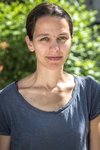share
© MSF
Bérangère Gohy works as a Rehabilitation Specialist at HI. She has co-ordinated, in partnership with Médecins Sans Frontières and Karolinska Institutet, a research project aimed to assess and refine a tool to measure mobility independence of people after a trauma.
We asked her a few questions about the research project, and its relevance for people who have experienced traumas.
 Severe injuries are common in humanitarian settings, caused not only by violence, but also by falls, road traffic or work accidents. Most patients need immediate medical attention, and often require surgery. The lucky ones reach a specialized hospital; but most of them will remain out of reach even for surgical care. When they do get access to a surgeon, the priority is mainly on saving life and limbs; not much attention is paid to ensure they can return to daily life activities afterwards.
Severe injuries are common in humanitarian settings, caused not only by violence, but also by falls, road traffic or work accidents. Most patients need immediate medical attention, and often require surgery. The lucky ones reach a specialized hospital; but most of them will remain out of reach even for surgical care. When they do get access to a surgeon, the priority is mainly on saving life and limbs; not much attention is paid to ensure they can return to daily life activities afterwards.
But trauma care is not only about saving lives, it is also about ensuring that people can live at their best potential, resume their activities like education, work, and social life.
Measuring the patient’s independence in daily life activities allows to encourage early mobilisation and to improve the quality of care provided to the patient, by acting in a timely manner if difficulties are identified, putting in place rehabilitation programs adapted to the patient’s needs and other medical protocols as needed.
Having in mind the importance of measuring independence depending on contexts, our research aimed to assess whether the “Activity Independence Measure for Trauma (AIM-T)” was a valid tool to be used widely in humanitarian settings.
The AIM-T was first developed in Afghanistan by a team of HI and MSF physiotherapists, who observed that, even though the needs of each patient after trauma are different, they all have to be able to perform some common movements in their daily lives.
With this in mind, the team identified 20 basic movements. These were relevant at that time in that Afghan hospital, and were helpful in the daily practice for this particular team of physiotherapists.
Then, the AIM-T was also used by other teams in other countries. Before recommending the AIM-T for wider use, we needed confirmation about its validity and reliability: are those 20 movements suitable for all patients, of all ages, in all cultures? Is the AIM-T easy and quick enough to be used by overloaded teams? Is the tool giving reliable figures across therapists? Those were the questions behind this research project, which was carried out in different humanitarian settings (Yemen, Iraq, Burundi, Cameroon, Central African Republic and Haiti).
The data collected from 635 patients and the structured interviews with 23 health care professionals and 60 patients, allowed us to understand how the AIM-T should be improved.
The tool was shortened from 20 to 12 “basic movements”, to be more adapted for settings with time constraints and limited resources.
In addition, some of the “basic movements” in the tool were revised. For example, “putting on pants” being a part of the initial tool, made some patients uncomfortable and was therefore not often assessed. It was changed to “reaching lower back and grab clothes”, which is considered more appropriate while still evaluating the ability of the patient to use their arms and hands while dressing up.
This study showed that the revised version of the AIM-T is now suitable across different cultures, quick and reliable. Therefore, it can be used across a range of humanitarian contexts.
I think that Ramin’s story can illustrate well the impact on people. I met him during my first day as a Humanity & Inclusion physiotherapist in the Médecins Sans Frontières trauma center in Kunduz, Afghanistan, in 2011. Ramin, 10 years old, entered the consultation held in his father’s arms. He was operated on in the hospital a few weeks before, after a gunshot wound to the leg. The wound was clean and, based on medical advice, there was no need for further follow-up. Why wasn’t Ramin walking, as he should have by then? Well, it turned out that nobody actually had told him it was safe for him to move his leg, nor to stand and walk. Probably he was in pain, afraid of getting re-injured, so he just stayed in bed.
The use of measures, like the AIM-T, to quickly assess independence in daily activities, can prevent other patients from having a similar experience to Ramin, and eventually improve their recovery after a surgery, by encouraging them to mobilise earlier on.
Bérangère Gohy co-authored this scientific article that has just been published in PLOS Global Public Health : Monitoring independence in daily life activities after trauma in humanitarian settings: Item reduction and assessment of content validity of the Activity Independence Measure-Trauma (AIM-T)








HI is an independent and impartial aid organisation working in situations of poverty and exclusion, conflict and disaster. We work alongside people with disabilities and vulnerable populations, taking action and bearing witness in order to respond to their essential needs, improve their living conditions and promote respect for their dignity and fundamental rights.
HI is an independent and impartial aid organisation working in situations of poverty and exclusion, conflict and disaster. We work alongside people with disabilities and vulnerable populations, taking action and bearing witness in order to respond to their essential needs, improve their living conditions and promote respect for their dignity and fundamental rights.